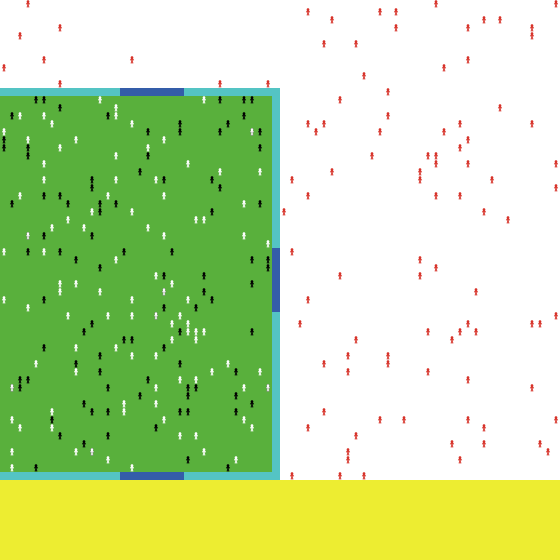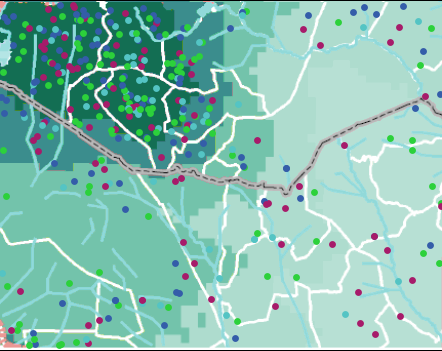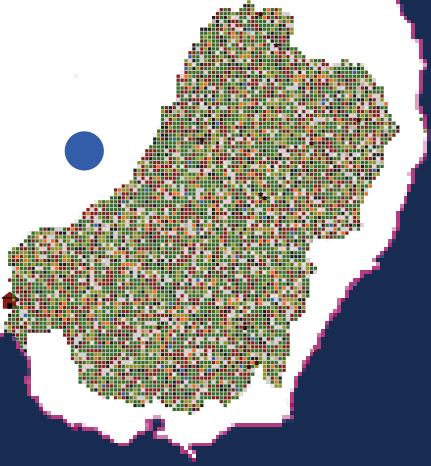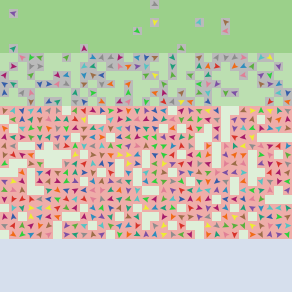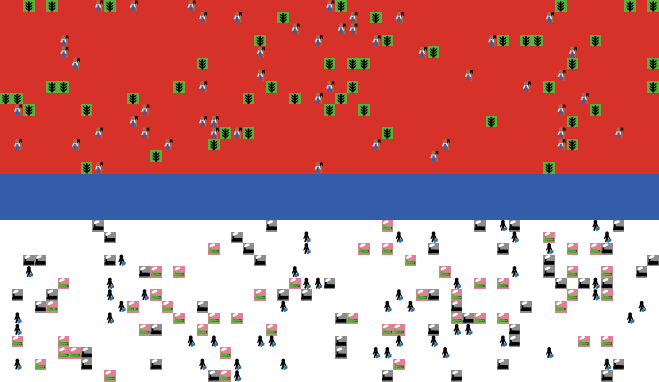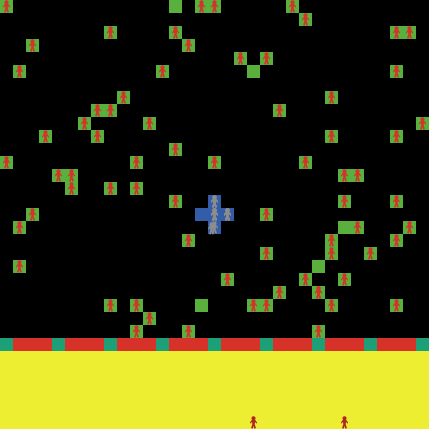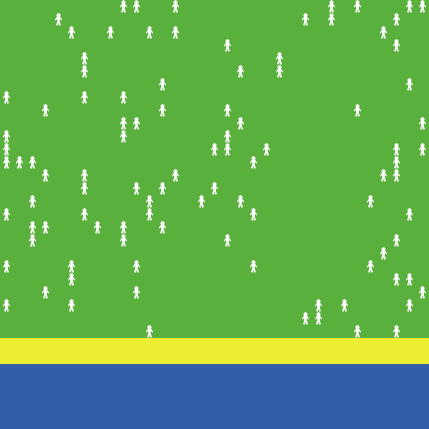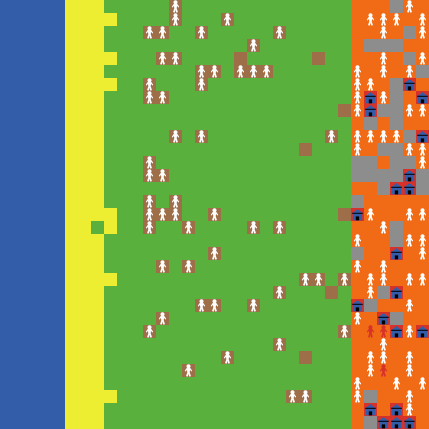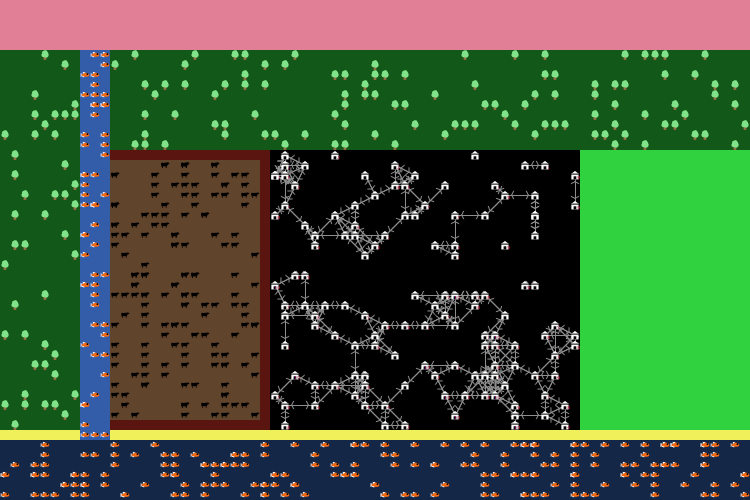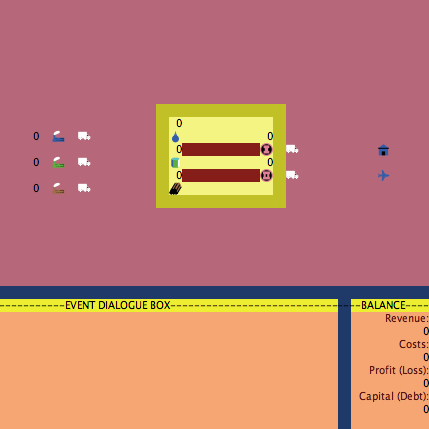NB: Quick-link to this page with: http://tinyurl.com/MonIEMProjectGallery2010
Welcome to the 2010 Integrated Economic Modelling Gallery ...
Below are the final versions of projects submitted by students in Integrated Economic Modelling (ECC/ETC 3860) at Monash University, Melbourne, Australia, October 2010. The Unit is delivered at the third-year (upper undergraduate) level, and presented students with challenging concepts from Complex Systems Science and Agent Based Modeling. Students were trained in [ccl.northwestern.edu/netlogo/ NetLogo] through smaller assignments, then asked to work on a five-week Major Project in one of four key areas: Conflict, Water, Poverty/Climate and The Firm. A sample of the fruit of these labours is given below. If you have any questions about these models or wish to contact one of the authors, please contact Dr Simon Angus (<Simon DOT Angus AT monash DOT edu>) or Dr Brett Parris (<Brett DOT Parris AT monash DOT edu>).
NB: Code is made available for research and educational purposes. The authors of each project remain the sole copyright owners.
The Models
Conflict
Water
Poverty & Climate Change
The Firm
The Models
Conflict
Project Title |
The Gaza Conflict |
|
Author |
James Gregory |
|
About |
The model provides an idea of the conflict dynamics between Israel and the Gaza Strip. It depicts how Israel controls the borders and shows the effects of its control on the citizens of Gaza. Depending on the number of agents in the model, interactions occur amounting to conflicts between the Hamas, (terrorist organisation running Gaza), and Israeli soldiers. When Israeli soldiers come into a given radius of a Hamas member, a conflict will occur. Conflict levels fall naturally periodically as this accounts for the idea that people forget about past history and move on. However, if conflict is occurring to a sufficient level, Israel may choose to close a border/gate reducing supplies into Gaza. If Israel becomes aggravated enough, all gates may end up closing which results in catastrophic consequences for the people of Gaza. Such an effect will reduce the happiness and health of the population leading to increased warfare and rebellion from the citizens of Gaza. |
|
Code |
||
Project Title |
Conflict and Farming on the Ethipia/Kenya Border |
|
Author |
Penelope Mealy |
|
About |
This model simulates the interactions and conflict operating between pastoralists of different ethnicities in a 460 x3 80 km area where southern Ethiopia meets Northern Kenya. Pastoralists move their livestock from pasture to pasture to take full advantage of a heterogeneous landscape and precarious climate in this region. Competition between pastoralists of different ethnicities over scarce and widely dispersed forageable land often erupts into violent conflict. Many studies indicate that droughts in Africa often exacerbate resource-based conflict. As climate change models predicting increases in frequency and intensity of droughts within East Africa over the next 50 years, this model examines the influence of 5 possible drought scenarios on conflict levels between pastoralists. Given the uncertainty surrounding climate-change induced changes in rainfall levels and variability, and the significant differences in predictions between regions, this model omits water supplies and looks primarily at pastoralists’ conflicts over productive land. Droughts reduce the lands’ productivity by either 20% or 50% and can be set to occur every 5 years or every 2 years by the observer. |
|
Code |
||
Water
Project Title |
Modelling the Murray Darling Basin |
|
Author |
Genevieve Gardner |
|
About |
This NetLogo File is a model of the Murray Darling Basin (MDB). Located in the south-eastern part of Australia the Murray Darling Basin covers approximately 14% of Australiaís land mass. The Basin is one of the highest producers of agricultural commodities in Australia producing $15 billion of agricultural commodities in 2005-06 totalling 39% of Australia's total agricultural output (ABS, 2008). The MDB area also has great cultural, social and environmental significance. Recently problems with over-allocation of water resources, particularity to the agricultural sector that uses 65% of the basin's water, has led to environmental degradation in the basin. This model is designed to enable the right level of water-allocation to farms in the basin to be reached, while also showing the impact that water allocation reduction will have on the farming industry. |
|
Code |
||
Poverty & Climate Change
Project Title |
Climate Change and Poverty in a Coastal Community |
|
Author |
Victor Khov |
|
About |
One of the most active research areas in integrated modelling is in the overlaps between poverty and climate change. Many interlocking factors keep people poor, including poor health, low levels of education, unemployment, geographic isolation, war, and natural diasters. Climate change is expected to exacerbate poverty at a time when many countries are making major efforts to try to reduce poverty. This very simple model attempts to measure the effect of climate change on a village already inflicted with the strains of poverty. |
|
Code |
||
Project Title |
Climate Change and Economic Development |
|
Author |
Andrew Leslie |
|
About |
An ABM modelling the effects of climate change on the living standards of people in both developed and developing nations. Each person, confined to his country, walks around making income and emissions. Emissions contribute to an aggregate CO2 level which effects the temperature level. A certain temperature level starts to flood, destroying workplaces and income. |
|
Code |
||
Project Title |
Climate change and poverty in Lesotho |
|
Author |
Jonathan Main |
|
About |
This model aims to represent the decisions that a subsistence agriculture based community in Lesotho (a small country landlocked by South Africa, population: approximately 2 million) have to make when faced with climate change and falling rainfall. It aims to show the impact on the poor community's livelihood as their harvest is directly dependent on how much rain falls. The community is made up of farmers and town workers. Their livlihoods are not affected when rain falls at base level or when there is no climate change, however when there is climate change, rainfall is negatively affected and if their level of wellbeing reaches a critical level these community memebers will have to make the decision to either migrate to South Africa to get a labouring job or move to the town to find non-farm employment. However, for some community members the move is too difficult and they will die. The model aims to explore the differnt kinds of conditions that lead to a family making this kind of decision and at what point in time they make them. |
|
Code |
||
Project Title |
The Impact of Climate Change on a Coastal Village in Sri Lanka |
|
Author |
Bindhu Rajendra |
|
About |
In this model, agents represent households. Thus, if the agent is alive, healthy, is earning an income etc, all members of the household is also alive, healthy and has an income. Households can earn an income by two ways. 1) Farming 2) working at the local factory. The factory is located in inner regions of the town, and hence in this model will not be affected by tsunamis and flooding. However those working in the farms closer to the coast are vulnerable . Households are taxed, at a rate of 10% of their income. This pool of money is used for government expenditure, both related and unrelated to climate change. When facing the adverse affects of flooding and tsunamis, it is from this pool of money that the money will be drawn from. There are two expenditures that agents make in this model 1) Food 2) Education. The main priority is food and 70% of income is spent on food. Education is only secondary. Thus, if the household is facing financial difficulties, the education of the children will be sacrificed. Each tick in this model represents a week. Households are paid weekly and are also taxed weekly. Crop productivity is central to the model, affecting many variables (income, employment status, food intake and health). Initially, it is set to a business as usual value, and may be affected by floodings and tsunamis (depending on where the farm is located). Food intake is a function of income and crop productivity and health is a function of food intake. |
|
Code |
||
Project Title |
Climate Change and Poverty in East Chila (Bangladesh) |
|
Author |
James Smith |
|
About |
Currently, flooding occurs 2 to 4 times per year, and cyclones affect the area 3-5 times per year, with 47% of the population reporting to be affected by flooding, and 65% of the population reporting to be affected by cyclones (Mahmood et al., 2010). According to the National Capacity Self-Assessment for Global Environmental Management (NCSA) (2007), ìglobal warming is apprehended to lead (to) a higher atmospheric temperature, high intensity of rainfall, increased natural disasters, more frequent and prolonged droughts and sea level along the coastal areas of low lying Bangladeshî (Mahmood et al., 2010). Thus it becomes important to attempt to build a model that could shed some insight on the future of small villages such as East Chila in the face of a changing climate. This model simulates climatic effects on a population of a river-side village comprised of farm land and inner-city housing. In particular, it models the effects of different tax rates under three scenarios. There are 2 climate change scenarios: The Best Case Scenario and The Worst Case; and one Policy Implementation Scenario. |
|
Code |
||
Project Title |
Effects of Climate Change on a Coastal Community living in Poverty |
|
Author |
Richard Xin |
|
About |
After being lucky enough to travel to Botswana in Year 12, I began to understand how lucky I was to live in a country like Australia. To have three meals on the table every day was not a usual occurence for some of the people that I met. However, even in such a poor community, the richness of their spirit radiated through the slums in which they lived. In this Netlogo model, an attempt is made to examine the effects of climate change on a coastal community living in poverty. Through increases in temperature and rises in sea level, we can investigate the impact of climate change on important factors such as population size, happiness and income. We are also able to model the devastating effects of sea level rise and deforestation, highlighting the potential for agents to learn and mitigate from previous experiences and situations. |
|
Code |
||
The Firm
Project Title |
Victory: a model of a textiles manufacturing firm |
|
Author |
Pak Ng |
|
About |
This model is intended to demonstrate the working process of a clothes manufacturer, called Victory. In this model, we will look at how tax rate, wages, cost of goods and contracts available affect the company's preformance, in terms of financial situation. The working process of this firm starts from receiving an clothing order from a retailer manager, who are called "managers" in the model. Designers will then understand the request of the managers and try to design the product fits the expectation. However, designers who are paid very low will seriously cannot captable to meet the requirement of the manager. Their bad performance will have a significant damage on customer base. The process will pass to patternmakers, we strongly suggest you to employ only one patternmaker because one is enough for the job in this model. However, that is alright if you want extra. After a pattern is made, the pattern will be taken to the cutters. While they are going to cut the fabrics, their preformance is also reflected through fabrics. For a better performed cutter, s/he can make more fabric parts from a single unit of fabric. this will have direct effect to the fabric cost. After parts are done, the parts will be transported to sewing area. The sewists will then transform the parts with a clothes (a shirt for instance). Sewists will make use of suppliments and filaments to get the clothes done. In this model, 1 unit of parts will produce 1 unit of clothes in order to simpify the model. Similar to cutters, their preformance will be shown through the use of filaments and suppliments determined by wages. |
|
Code |
||
Project Title |
A Manufacturing Firm Model |
|
Author |
Cameron Tantau |
|
About |
This Manufacturing Firm Model has been designed to investigate several questions posed to various types of manufacturing firms based in Australia. In particular, it has been designed as an attempt to vaguely recreate the behaviour and scenarios faced by firms on a day-to-day basis, and to observe how profits are effected when the firm is presented with certain challenges, namely: -How is profit and production affected: -when the firm decides to increase the prices of its goods? -when the firm decides to decrease the prices of its goods? -when there is a surge in the price of oil? -when nearby suppliers shutdown, such that the firm is forced to source its production inputs from factories that are located much further away? -by a shortage of labour? -by a surge in labour wages? -when input inventory levels are kept to a minimum in order to keep inventory costs down? -when the strength of the Australian dollar plummets? -when the strength of the Australian dollar surges? -when higher capacity delivery trucks are used? The main research questions that have been addressed in my report are: -the effect of a surge in oil prices -when nearby suppliers shutdown |
|
Code |
||



